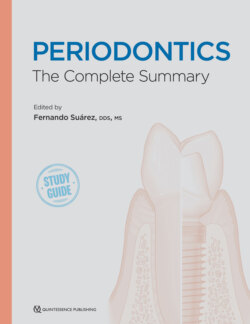Читать книгу Periodontics - Fernando Suarez - Страница 88
На сайте Литреса книга снята с продажи.
MECHANISM OF CALCULUS ATTACHMENT
ОглавлениеIn 1953, Zander explored the mechanisms of calculus attachment upon 50 freshly extracted teeth.31 Four main types of attachment were identified: (1) secondary cuticle, (2) direct attachment into irregularities of cementum, (3) penetration into cementum, and (4) mechanical retention in areas of resorption. In addition, various forms of combinations were also described (Box 5-1).31 Types II (20%) and III (10%) were noted as the most frequent modalities of calculus attachment, and the cementoenamel junction (CEJ) was the favored site for calculus formation.31
BOX 5-1 Mode of calculus attachment to cementum31
| Type IType IIType IIIType IVType VType VIType VIIType VIIIType IXType X | Secondary cuticleDirect attachment into irregularities of cementumPenetration into cementumMechanical retention in areas of resorptionCombination of Types III and IVCombination of Types II, III, and IVCombination of Types I, II, III, and IVCombination of Types I and IICombination of Types II and IIICombination of Types II and IV |
Following Zander’s findings, multiple authors questioned specific types of calculus attachment and attempted to employ more sophisticated technology to test his conclusions.19,32–40 Notably, Canis et al rejected the possibility that microorganisms can penetrate the cementum surface and considered this phenomenon as an artifact due to superimposition of a detached cementum onto the tooth structure during sample preparation.41 These findings were confirmed using light microscopy, scanning electron microscopy (SEM), and transmission electron microscopy (TEM).
